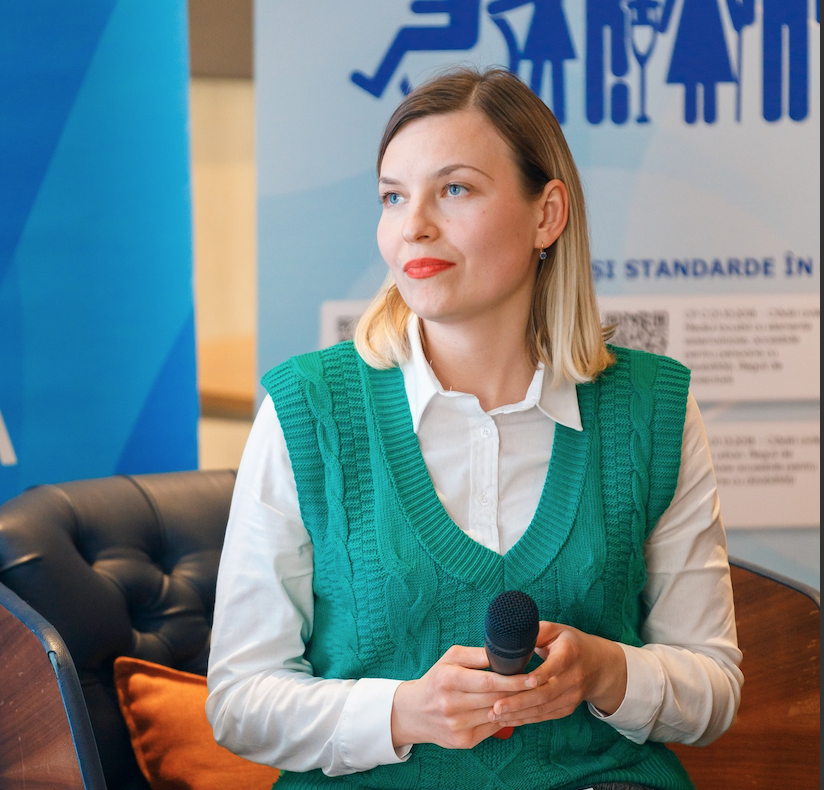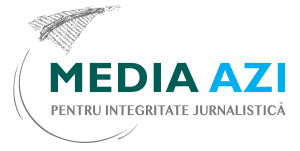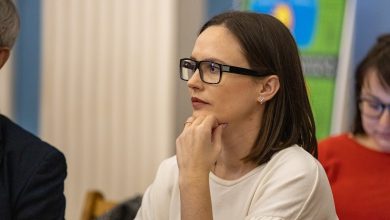Inclusion Starts with our Own Attitude. Journalists Are No Exception

Victoria Boțan
journalist, civic activist, specialist in public relations at the MOTIVAȚIE Association from Moldova
“There are no people with disabilities. There are societies that create barriers and difficulties for people with different needs. Disability is contained in society itself, not in the physical condition of each individual.” These words by Simon Brisenden also represent the vision of the Association where I have been working as a public relations specialist for more than six years. As a person with a locomotor disability, I can say from my own experience that, in the Republic of Moldova, unfortunately, the medical and the charitable models of approach to persons with disabilities persist. The media is no exception.
The medical model implies that persons with disabilities are not perceived as the normal ones, but are seen as beings who need treatment and play a passive role in society because they cannot live an independent life and always need someone else’s assistance.
Most of the persons with disabilities from Moldova I know, including me, have received money on the street from passers-by at least once. I have concluded that you can have a luxury car and a flawless appearance, but if you use a wheelchair or have a visible disability, even beggars will try to hand you some money in the Republic of Moldova. Our people are kind at heart and eager to help, but often they do not know how to do it in a right manner; besides, they can make a decision for you without asking you.
I know a boy in a wheelchair who was waiting for the trolleybus at the station, and when the first trolleybus appeared he was pushed inside without being asked, even though he did not need to go in that direction.
It is normal to be unaware of certain things, but it would be better to ask first whether the person in question needs your assistance and what exactly it consists of.
Another example of a medical approach to persons with disabilities in society is when a person in a wheelchair goes to the doctor, planning to have a baby, and the doctor asks this person how she could take care of the baby or whether she is not afraid that the baby could also have a disability.
In 2016, the Reproductive Health Training Center (RHTC) prepared a report titled “Situation Analysis of the Issues Confronting Women and Girls with Locomotor Disability in Moldova in Exercising Their Sexual and Reproductive Rights”. According to the findings from this report, some women with disabilities are faced with reduced access to sexual and reproductive health (SRH) services, including family planning, because they have experienced what they regard as discriminatory attitudes. One third of these women and their family members believe that healthcare workers’ attitude towards persons with disabilities addressing for SRH services is unfriendly and accusatory, which is a major barrier to access to healthcare services.
According to the same report, specific cases of breaching reproductive health rights of persons with disabilities, including cases of sexual violence, were reported during the assessment:
• a family doctor refused to refer a woman with disabilities to a gynecologist, explaining that she did not need that visit;
• a doctor suggested a woman with disabilities should terminate her pregnancy;
- during a visit to the gynecologist, a doctor refused to take a smear from a woman, saying he was not obliged to help her climb the gynecological chair which was not adapted for patients with locomotor disabilities.
The charity model refers to the journalistic materials in which persons with disabilities are described with an emphasis on the tragic situation they are supposedly in. These persons are presented as helpless people who are unable to take care of themselves and deserve pity, and are therefore an object of charity.
I guess the most correct approach to disability is based on respect for human rights. More exactly, they should be treated as equals, the protagonists of the materials should be treated with respect and dignity, their personal and professional skills should be emphasized, as they are equal members of society who can and are eager to contribute to the development of the community they belong to.
In this context, journalists play a very important part in promoting social inclusion of persons with disabilities by means of:
- using ethical terminology based on the approach to a person from the perspective of their personality, not their diagnosis. Even if people with disabilities use a wheelchair, they are not “wheelchair bound” or “sadder than we are.” Their equipment is not a reason for showing pity. It helps them stay more active and mobile and live an independent life. You can find more details and examples in the booklet titled “Writing about Persons with Disabilities Correctly”;
- drafting and promoting the success stories of persons with disabilities so that their voices could be heard. Still, attention should be paid to the approach. Avoid the two extremes: a “hero” or a “victim.” A person with disabilities is not a hero just because of being able to cope with ordinary things (study/work/taking care of their family) and facing some obstacles;
- not labeling a studio guest as a “person with disability.” If several people are invited to a show as experts and you present them by mentioning their functions, treat them in the same manner: they also have an important part in the show, as well as a function;
- informing you colleagues and raising their awareness of the sphere of disability;
- empowering the authorities in charge to create conditions of accessibility for all citizens who visit public institutions. The Accessibility Map drafted by the MOTIVAȚIE Association in 2011 includes 3762 objects in Moldova (social, cultural, educational, and healthcare institutions, enterprises, NGOs, police stations, and polling stations). Only 172 out of 1619 public institutions assessed and included in this map are fully accessible for persons with reduced mobility (elderly people, persons with disabilities, parents with babies in strollers, etc.), 369 are partially accessible, and 1078 are inaccessible. What do these statistics mean in real life? For instance, fewer persons with disabilities can accept a vacancy because its location is inaccessible, even if they have all the required skills and are eager to work.
An inclusive society starts with simple things. Please keep the following things in mind.
- Persons with disabilities need acceptance and respect instead of your pity, just like any other person. They do not want to hear phrases like “Oh, he/she is so poor!” or “We pity you so much for being disabled!” or “You’re so handsome/pretty, but crippled.”
- Persons with disabilities are not children; they can make their own decisions. They are able to work, to study, and to have a family and an active lifestyle. They can be parents, siblings, pupils and students, employees and employers, colleagues, neighbors, etc.
- Persons with disabilities can start their own families and give birth to absolutely healthy children.
- Disability is not a disease.
- Do not offer persons with disabilities money on the street, especially if they refuse to accept it in a diplomatic way. Persons with disabilities are not poor. They can also have well-paid jobs and hold the posts of directors, managers, chief accountants, doctors, journalists, etc.
- Before helping a person, ask them if they need your assistance and what exactly you have to do to help them.
- When talking to a person with disabilities, address them instead of those who supervise/help/accompany them.
- – Give up your seat in public transport to a person with reduced mobility, addressing them as Mr. or Ms., without resorting to such discriminatory terms as “disabled” or “crippled.”
While talking to a person with disabilities, not to damage their dignity, avoid questions such as:
- “What happened?”, “Why do you move like that?” or “Were you born this way or did you have an accident?” especially without establishing preliminary contact with the person or even knowing their name. They will think that you are more interested in their disease than in their personality. No one has to justify themselves explaining their disability, especially among strangers.
- While preparing journalistic materials, avoid the question “But what is your diagnosis?” if this is not strictly necessary due to the topic of the report. Even in this case, we can only do it with the person’s consent (for example, for a charitable activity). A diagnosis is personal information protected by the legislation. Everyone deserves to be treated with dignity.
- It is irritating for a person to be asked on weekday mornings by the neighbors, for instance, “Are you going for a walk?” It creates an illusion that the person is unable to work or cannot be involved in any important activity.
What does social inclusion of persons with disabilities start from? From your own example and the behavior of well-informed citizens who are open to accepting diversity and aware of other people’s rights and needs. We could become better starting from our families, from our places of study and work, and via the impact we shape together at the local, national, and global levels for promoting the rights and positive image of persons with disabilities in society. I believe that when we see more persons with reduced mobility on the street, in shopping or leisure areas, in public transport, as our colleagues, or in central and local public administration, we will realize that we live in an inclusive society where everyone can contribute and enjoy free access to services.
I close my eyes trying to imagine this is happening in Moldova. You will probably say I’m a dreamer, but I guess it’s worth at least starting from our own example.




